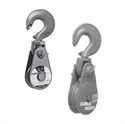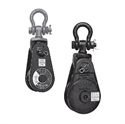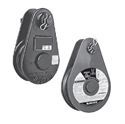Snatch Blocks
Snatch Blocks With Hook
Snatch Blocks With Shackle
Tailboards
One of the most widely used blocks on the market today are snatch blocks. A snatch block, by definition, is a block that can be opened on one side to insert a rope, thereby avoiding the necessity of threading the rope through from one end. Snatch blocks are not designed for longs lifts and continuous service as construction and crane blocks are.
Horizon Cable Service provides snatch blocks with hooks, snatch blocks with shackles, and tailboards with capacities up to 60 tons from McKissick as well as many other top manufacturers. These offerings are available with a wide array of sheave sizes and can accommodate wire rope or synthetic rope from 5/16” - 1 ¼”. Horizon Cable's selection of blocks and tailboards all come standard with an easy open feature which makes it easy to reeve the block without removing any fitting from the end of the wire rope or synthetic rope of choice. We also have the alloy options for snatch blocks and tailboards with a 40% weight reduction versus conventional blocks. Horizon can also customize any snatch block or tailboard for your specific application to handle any working load limit per customer request.
The following information should be specified:
1. Stock number (if known)
2. Sheave Size
3. Block Number (Catalog Number)
4. Number of Sheaves
5. Type of Bearing: (BB) Bronze Bushed, (RB) Roller, (TB) Tapered Roller
6. Type of Block (Snatch Block with Hook, Snatch Block with Shackle, or Tailboard)
7. Wire Rope or Synthetic Rope Diameter
To select a snatch block or tailboard to fit your requirements, consider the following points:
1. Are there regulations which could affect your choice of blocks or tailboards, such as federal or state OSHA, elevator safety, mine safety, maritime, insurance, etc.?
2. What is the weight of the load, including any dynamics of impacts that add to load value? You must know this to determine the minimum required Working Load Limit value of the block or tailboard.
3. How many parts of line are required? This can be determined given the load to be lifted and the line pull you have available. As an alternative, you could calculate the line pull required with a given number of parts of line and a given load weight.
4. What is the size of line to be used? Multiply the available line pull by the desired safety factor for wire rope or synthetic rope to determine the minimum catalog wire rope or synthetic rope breaking strength; consult a wire rope or synthetic rope catalog for the corresponding grade and diameter of wire rope or synthetic rope to match. You should also consider fatigue factors that affect wire rope or synthetic rope life.
5. What is the speed of the line? This will help you determine the type of sheave bearing necessary. There are several choices of bearings suitable for different applications.
6. What type of fitting is required for your application? The selection may depend on whether the block will be traveling or stationary. Your choices include single or multiple hooks with or without throat latches and shackles, which are the most secured load attachment. You should also decide whether the fitting should be fixed, swivel or swivel with lock.
7. How will the block or tailboard be reeved and does it require a dead end becket?
8. If the block is to be a traveling block, what weight is required to overhaul the line?
9. What is the fleet angle of the wire rope? Line entrance and exit angles should be no more than 1 1/2°.
10. How will the snatch block or tailboard be maintained? Do conditions in your application require special maintenance considerations?
Snatch Block and Tailboard Maintenance
Blocks and tailboards must be regularly inspected, lubricated, and maintained for peak efficiency and extended usefulness. Their proper use and maintenance is equal in importance to other mechanical equipment. The frequency of inspection and lubrication is dependent upon frequency and periods of use, environmental conditions, and the user’s good judgment.
Inspection:
As a minimum, the following points should be considered:
1. Wear on pins or axles, rope grooves, side plates, bushing or bearings, and fittings. Excessive wear may be a cause to replace parts or remove snatch block or tailboard from service.
2. Deformation in side plates, pins and axles, fitting attachment points, trunnions, etc. Deformation can be caused by abusive service and/or overload and may be a cause to remove snatch block or tailboard from service.
3. Misalignment or wobble in sheaves.
4. Security of nuts, bolts, and other locking methods, especially after reassembly following a tear down inspection. Original securing method should be used; e.g., staking, set screw, cotter pin, cap screw.
5. Pins retained by snap rings should be checked for missing or loose rings.
6. Sheave pin nuts should be checked for proper positioning. Pins for tapered roller bearings should be tightened to remove all end play during sheave rotation. Pins for bronze bushings and straight roller bearings should have a running clearance of .031 inch per sheave of end play and should be adjusted accordingly.
7. Hook or shackle to swivel case clearance is set at .031 to.062 at the factory. Increased clearance can result from component wear. Clearance exceeding .12 to .1.18 should necessitate disassembly and further inspection.
8. Deformation or corrosion of hook and nut threads.
9. Surface condition and deformation of hook (See Fitting Maintenance and ANSI B30.10.)
10. Welded side plates for weld corrosion or weld cracking.
11. Hook latch for deformation, proper fit and operation.
Lubrication:
The frequency of lubrication depends upon frequency and period of product use as well as environmental conditions, which are contingent upon the user’s good judgment. Assuming normal product use, the following schedule is suggested when using lithium-base grease of a medium consistency.
Sheave Bearings
Tapered Roller Bearings — Every 40 hours of continuous operation or every 30 days of intermittent operation.
Roller Bearings — Every 24 hours of continuous operation or every 14 days of intermittent operation.
Bronze Bushings — (Not Self Lubricated) — Every 8 hours of continuous operation or every 14 days of intermittent operation.
(The Crosby Group, Inc. Tackle Block Warning, Use & Maintenance Information)








